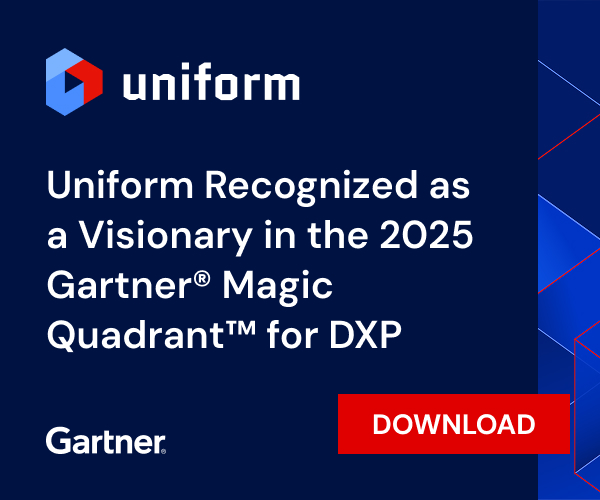Uniform blog/How a composable DXP will future-proof your technology stack
How a composable DXP will future-proof your technology stack
How a composable DXP will future-proof your technology stack
Future-proofing is the process of investing in and implementing viable tools and systems that will adapt and remain effective amid shifting demands and emerging technologies.
In a world where change never stops, a technology stack built with future-proof software like a composable digital experience platform (DXP) evolves with your business, helping you deliver better, faster omnichannel experiences during market highs and lows.
Here’s why a composable DXP is the right option for future-proofing your stack and simplifying the digital experience management process.
Agile and scalable enterprise solutions
Future-proofing your organization against volatility requires technology that empowers marketers to do their best work unimpeded and developers to focus on innovation instead of clearing IT backlogs.
The first step to building a future-proof foundation is selecting a solution that not only aligns with your budget, stakeholder needs, and overall vision but also focuses on architectural openness and flexibility.
Below are areas where sustainable platforms, particularly those capable of withstanding rapid changes, excel:
- Comprehensive documentation that outlines a strategic roadmap that accelerates implementation and reduces dependency on development resources.
- Powerful APIs that provide stable architecture, remove friction from development prints, and create forward momentum for developing new features.
- Direct communication that encourages open dialogue with the vendor’s engineering team and technical leadership, not just sales reps.
- A large, vibrant user community that helps tackle real-world implementation challenges beyond vendor-controlled demos.
- Transparent feature retirement processes that demonstrate the vendor’s maturity to manage customer transitions seamlessly and pivot without accumulating technical debt.
The most agile DXPs aren't always the most prominent names or highest-ranked in analyst reports. Platforms that embrace a composable approach, modern engineering principles, and architectural discipline tend to demonstrate greater evolutionary capacity than enterprise heavyweights encumbered by legacy code.
The composable advantage
The DXP landscape is vast, ranging from comprehensive suites to CMS-centric solutions. However, traditional and even composable-adjacent platforms can box you into proprietary front-end frameworks that result in:
- Complex tech stacks that create security vulnerabilities and increased risks.
- Testing requirements that turn into long sprints and development cycles for launching campaigns.
- Custom code-specific capabilities that require developers and hinder marketers.
- Static digital experiences that impact site performance, brand perception, and customer satisfaction.
By contrast, DXPs with a composable approach offer structural flexibility and accommodate emerging technologies, regardless of source or vendor.
There are several advantages to future-proofing your stack with a composable DXP:
- Modernize incrementally. A composable DXP lets you replace individual components without dismantling your entire infrastructure or disrupting your digital experience. You can easily update your CMS, PIM, DAM, and other enterprise systems as budgets fluctuate, regulations evolve, and new channels emerge.
- Gain in-demand capabilities. Composable DXPs use no-code integration with best-of-breed tools or have native capabilities like generative AI, content management, and personalization, making building cohesive customer experiences simple and seamless.
- Empower digital teams. Composable DXPs like Uniform allow you to manage and launch experiences from multiple data and content sources through a unified visual workspace, giving greater control to marketers and minimizing developer involvement.
- Mitigate risk. If your legacy DXP provider fails to adapt to emerging requirements, your digital experience is compromised. Composable approaches distribute this risk across multiple vendors.
- Reduce costs. Replatforming a traditional DXP can lead to soaring costs and long, painful migrations. Your composable DXP leaves room for incremental investments, enabling you to keep existing systems or add new ones when your organization is ready.
Some organizations benefit from the deeper integration of monolithic platforms. Still, composable DXPs can be a powerful differentiator for brands and digital teams that want to run lean and operate efficiently.
By leveraging multisource visual experience management, easy integration of content, data, and technologies, and edge optimization for a faster time to market.
Uniform helps you prepare for an ever-changing landscape
Many DXPs offer new, exciting features. However, these solutions are weighed down by rigid platforms that create technical debt, complicate digital workflows, and prevent digital teams from moving swiftly and efficiently.
With a DXP, you get flexibility, agility, and technology that supports your tech stack and digital teams through uncertainty without sacrificing speed or must-have capabilities such as AI and personalization.
Get the 2025 DXP Playbook to develop a composable strategy that prepares you for the unknown. Or book a demo to see how Uniform’s composable DXP enables you to construct a future-fit stack.







